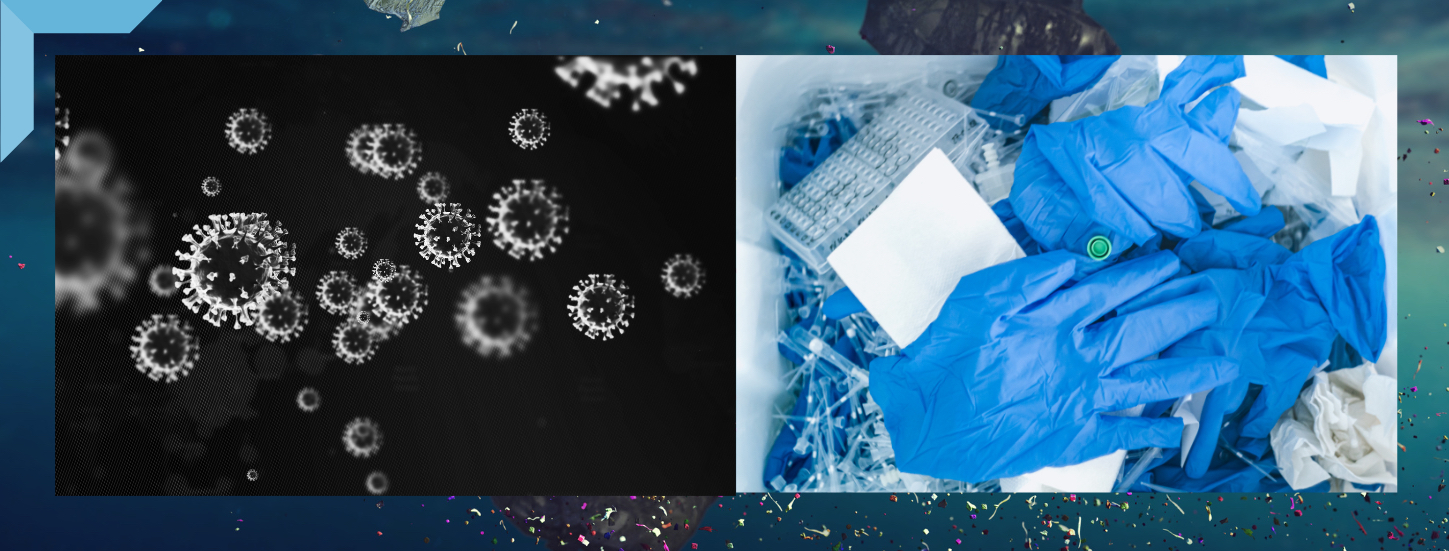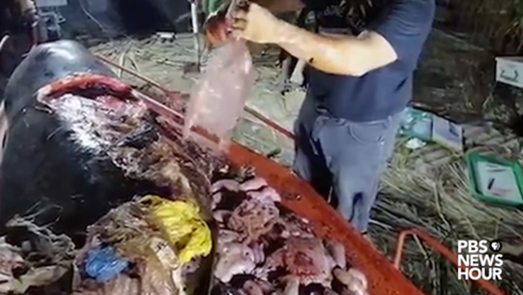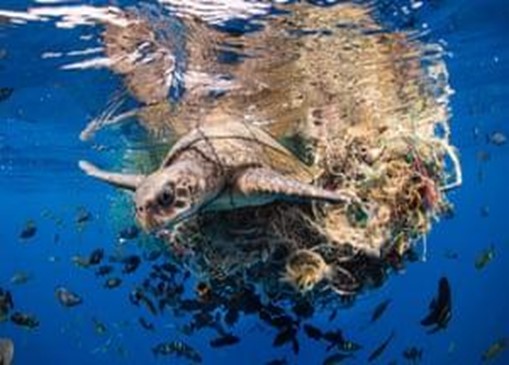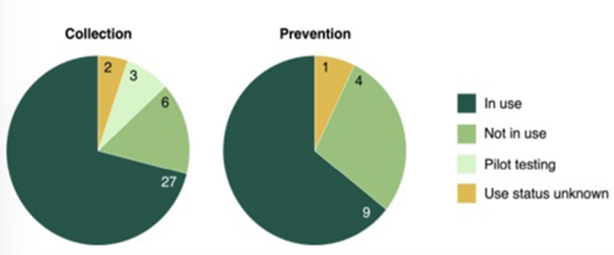
Illustrations by Délice Williams
Sick Ocean, Sick People: The Consequences of Medical Plastic Pollution in Our Oceans
The whole world was shaken when the Coronavirus Disease (COVID-19) caused a global shutdown and billions of lives were halted. The World Health Organization urged people all around the world to slow the spread of COVID-19 with personal protective equipment (PPE). Disposable facemasks, gloves, antigen tests, nasal swabs, and other protective items were carelessly discarded in mass, with one destination: the ocean. Approximately 8.4 million tons of pandemic-associated plastic waste was generated, and around 25,900 of that waste ended up in the Earth’s oceans (Cohen). In the past few years, the media has increasingly focused on environmental pollution stories about saving sea turtles from plastic straws and packaging plastic, but they don’t cover the story about a substantial contributor to this oceanic crisis: medical plastics. Medical plastics are detrimental to the destruction of marine ecosystems both directly from microplastic pollution that occurs when plastic waste disintegrates in the oceans, and indirectly through incineration. Without viable alternatives to the disposal of medical plastics, problems regarding ocean pollution will worsen exponentially. Currently, there is limited media and scholarly coverage regarding medical plastics and their negative impact on marine life. The ocean is drowning in medical plastics, and the government and the medical industry need to work together to recognize the harmful effects of medical pollution before it is too late.
In medical laboratories, hospitals, and clinics, sterility is the name of the game. This prompts healthcare personnel to emphasize the need for single-use plastics to prevent infectious diseases from spreading from one patient to the next. For example, in an interview with BBC news, Surgeon Claire Teves says that she uses devices such as plastic retractors that hold open surgical cuts, only once per patient, before she promptly discards them. Teves says, addressing sustainability is not really on our priority list; everything we do is about helping our patients” (Ngo). For hospitals, sanitization is important to ensure cleanliness to keep infectious diseases from spreading. Doctors, nurses, and surgical teams are focused on caring for patients rather than the environmental impacts of the waste they produce. The current hospital system is dependent on these plastics for their daily operation. Without the easy accessibility of single-use disposable medical devices, hospitals’ productivity might decrease. In addition, medical practices have come to rely on single-use disposable plastics because they are more cost-efficient compared to reusable devices and require no maintenance. Instead of sterilizing and maintaining medical equipment after each use, medical personnel can mindlessly toss the equipment into biohazard waste bins, which will eventually be sent to medical waste disposal services (Ngo). Currently, these plastics are disposed of through recycling or incineration, leading to destructive consequences for the marine environment. This problem challenges the medical field to adapt its practices so that saving human lives doesn’t come at the cost of harming the environment.
The majority of medical plastics are incinerated due to the concern of infectious diseases spreading. However, when plastics are incinerated, toxic pollutants such as dioxins and hazardous heavy metals, including lead and mercury, are released into the air. These compounds break down in the environment very slowly, meaning they often linger in the air. The ocean absorbs these toxic chemicals, and the chemistry of the ocean changes, becoming more acidic (Nawaz). This phenomenon, called ocean acidification, is harmful not only to ocean life but also to people. These contaminants move through the food chain and enter our bodies when we consume fish, which can cause health problems like cancer, liver damage, and congenital disabilities. Many incinerator facilities around the world burn around 70 tons or 140,000 pounds of plastic waste a day which emits approximately 9.8 pounds of carbon dioxide gas into the air (Budris). Despite well documented harmful environmental effects of incineration, it continues to be widely used around the world.
The use of incineration is increasing, despite its damaging effects on the environment. Unfortunately, the sheer scale of plastic production by companies means that much of this plastic ends up in the oceans. These plastics in the ocean ensnare sea animals, causing suffocation and entanglement that ultimately leads to the death of these animals. Over time, plastics can break down to become microplastics, which are just smaller pieces that finally revert back to their original form as pre-production pellets. These microplastics circulate in the water and are consumed by all aquatic animals. Microplastics are unintentionally eaten by fish, filtered through clams, and inhaled by sea turtles, resulting in harmful toxins leaching into their bloodstreams (Biamis et al.). Plastics themselves can contain toxic contaminants such as trace metals and harmful organic chemicals. If these toxins do not kill aquatic animals, the microplastics eventually make their way back to humans through the food chain (Pirsaheb et al.). Millions of people consume seafood and as a result, indirectly ingest traces of microplastics. In the documentary, The Plastic Problem, Chelsea Rochman, a scientist researching how plastics truly affect people, admits, I know plastic is in my drinking water, I know it’s in the air I breathe, so if I eat a piece of fish, it’s not that different” (Nawaz). Since the airing of the documentary, scientists have successfully verified that microplastics move through the food chain. However, the long-term implications of how they affect human health is still a mystery. Animals carry microplastics in their bodies, and when another animal eats them, those microplastics are also ingested. This process is called the trophic transfer” of microplastics (Plastic Soup Foundation). Plastic toxins can leach into animals’ bodies even when the animal does not directly ingest plastic. Additionally, microplastics can move and accumulate in animal fat and tissue or leak into the bloodstream and become ingrained in every part of the animal’s body. As humans, we eat these animals resulting in minuscule amounts of plastic toxins slowly building up in our bodies. Currently, the scientific community is still exploring the effects of plastic toxins on human health. The opportunity to preserve a healthy marine ecosystem is dwindling as the amount of plastic by weight in oceans will soon exceed the amount of fish by 2050 (Nawaz). The pressure to move away from both burning and the irresponsible disposal of medical waste is an increasingly pressing undertaking, but the alternatives are causing problems themselves.
Recycling is advertised as a solution that has the potential to end the ubiquity of the plastic problem. However, little do people know that recycling facilities are drowning in the large volume of plastics they receive daily, not only from the medical industry but also from people’s day-to-day lives. Despite educational and media promotions encouraging people to recycle more, recycling, in its current form, cannot solve the current plastic problem. This is because, recycling companies can only reuse a small fraction of the plastics people collect. Recycling warehouses are filling up with so much plastic that first-world countries like the United States are illegally dumping tons of plastics in third-world countries (Nawaz). These third-world countries are burdened with other nations’ trash. As a result, plastics are discarded mindlessly, often ending up in oceans or, in the best-case scenario, getting incinerated when they arrive (Nawaz). This practice does nothing to solve the underlying problem but merely moves the waste around in a type of shell game. When addressing the illegal transfer of recycled plastics, Malaysian Prime Minister Mahathir Mohamad said, we don’t need your waste because our own waste is enough to give us problems,” and he, like China, has recently banned the importing of recyclable waste (Nawaz). Recycling is often considered an economically viable alternative to discarding plastics in landfills or saving them from incinerators, but in reality, recycling creates more problems than it solves.
Another challenge associated with recycling is that recycled plastics must be sorted as there are many different types of plastic with varying levels of recyclability. As a result, evaluating recyclability is a prevalent challenge in all aspects of the world, including the medical industry. Although recyclability may seem very black and white, whether a product is recyclable or not, there are important nuances that determine it. Many companies and businesses are under the misconception that anything with a generic M?bius loop printed onto its packaging will make it recyclable. Many people will throw anything in a recycling bin in hopes that someone will make sure it will somehow get recycled. A lot of plastic packaging is recyclable if it can be collected, properly sorted, reprocessed, and then reused in manufacturing (Cramer). However, this requires correct processing through a multi-step process. Even if medical plastics are designed to be recyclable, there is a considerable possibility that the plastic will not meet the recycling company’s collecting criteria of what is acceptable. Other barriers to recycling include but are not limited to contamination, cost, and variety of plastic. Plastics are often contaminated by other substances causing the resins to not be clean for manufacturers to reuse them (Ferrario). Recycling facilities cost millions of dollars to build and operate, and the only way for recycling plants to be profitable is to treat huge amounts of plastics daily, which is often difficult because recycling is an intricate and detailed process. Due to low efficiencies and high costs, recycling is non-economical and non-beneficial. Many times plastics contain multiple types of plastics and different layers, which are blended together to create a more durable plastic, but these layers are difficult to separate, making recyclability even more difficult and costly (Ferrario). Even though the medical sector may have the intention to recycle single-use medical plastics correctly, many additional factors prevent facilities from recycling them. As a result, recycling facilities don’t have the infrastructure or manpower to tackle the scale of plastics that the medical industry generates (Blessy).
If the healthcare industry were a country, it would be the fifth-largest emitter of greenhouse gasses on the planet, which is equal to the greenhouse emissions from 514 coal-fired power plants (Jubb.). Total healthcare emissions are produced from transportation and distribution, electricity and other healthcare facility operation emissions, anesthetic gases, and end-life treatment of solid products (Karliner et al.). About 9.3% of all greenhouse gases emitted from the medical sector are from the disposal of plastic waste, which amounts to 186 million tons of emissions. However, only 15% of plastic healthcare waste is classified as hazardous,” meaning only 15% of all medical waste actually needs to be incinerated (Ngo). This means that approximately 158 million tons of greenhouse gases can be saved from entering the atmosphere. The rest of the plastic waste can be handled differently without the risk of disease.
Before any real solutions could be put in place, disaster struck in the form of a global pandemic. With the outbreak of the COVID-19 pandemic in 2020, single-use plastics relating to the medical sector have increased exponentially (Mondal et al. 439) . A study published by the Journal Proceedings of the National Academy of Science writes, “The recent COVID-19 pandemic has led to an increased demand for single-use plastic, intensifying pressure in this already out-of-control problem” (Cohen). The demand for personal protective equipment increased, which indirectly led to an increase in global waste production. COVID-19 altered the dynamic of not only hospitals producing single-use medical plastics but also the billions of people living on the planet. Waste generation has increased by 300% since the start of the pandemic and has had a negative impact on the planet (Nawaz).
Despite almost every country having rules and regulations that deal with plastics, millions of tons of medical plastics continue to end up in oceans. Due to the ubiquity of plastic, it is almost impossible to ban all plastic to ensure clean oceans. Plastics are an intrinsic part of human life. They are durable and light. They are used for storing every type of consumer good, for packaging, keeping food fresh, in electronic devices and appliances, and in our cars; plastic is everywhere. Taking away plastic would ultimately cripple the world’s infrastructure, but society has to address the pervasive plastic problem. In 2019, PBS released PBS NewsHour content specifically on the topic of plastic in a documentary called The Plastic Problem. This TV program includes harrowing images such as whales filled with plastic (figure 1), which show audiences the unseen damage that plastics have on the marine ecosystem. Despite increasing media and scholarly coverage of the negative impact of medical plastics on oceans due to the COVID-19 pandemic, the majority of people are still unaware of the massive amount of medical waste that facilities are disposing of in harmful ways every day. News outlets in the past few years have expanded their coverage of stories regarding plastics, and researchers from all over the world, in response to the COVID-19 pandemic, have recently started responding to this dilemma too by developing discourse among the scientific community. Shortly after the start of the pandemic, CBS news entered the discussion regarding medical plastic pollution to urge readers that excessive waste has been proven deadly for marine ecosystems. Non-profit organizations like the Plastic Pollution Coalition, are collaborating with global businesses, organizations, and individuals to create a world free of plastic pollution (Plastic Pollution Coalition). Award-winning photographers bring to light the destruction plastics have on the ocean as they often encounter plastic pollution (figure 2) when searching for the next award-winning shot (Fidler).

Figure 1. Pounds of plastic were found in the cut open body of this whale caught on a fishing boat. (Nawaz).

Figure 2. Conservation Photographer of the Year, Simon Lorentz, captures an Olive Ridley Sea Turtle entangled in a mass of ocean debris (Fidler).
Another dimension of medical plastics in the ocean is the massive garbage patches, the size of Texas, that circulate regions of the ocean and are beginning to dominate its landscape (Nawaz). Although garbage patch” may conjure an image of an island of floating trash, these patches are made up primarily of microplastics that the naked eye can’t always see. Even satellite imagery doesn’t show a giant patch of garbage,” as the microplastics make the ocean look like a cloudy soup (Evers). In the Pacific Ocean, patches of spinning debris are linked together by the North Pacific Subtropical Convergence Zone, where the warm water meets up with the cooler water from the arctic. The zone acts like a highway that moves debris together.” Ocean currents swirl the garbage patch into a vortex of plastic waste and debris, which breaks down the plastic into even smaller microplastics (Evers). In addition, these plastic vortexes extend below the ocean’s surface as denser plastics can sink up to several meters beneath the surface, while others can sink all the way down to the ocean floor (Evers). Ingesting larger pieces of marine plastics can be harmful to marine animals as they mistake plastics for food and feed it to their young or eat it themselves, which ultimately leads to their death from starvation or ruptured organs. Moreover, marine mammals such as seals are at risk of getting entangled in bigger plastics and drowning (Evers). Because garbage patches are so far from any country’s coastline, no nation will take responsibility for funding to clean them up. Oceanographer Charles Moore says, cleaning up the garbage patch would bankrupt any country [that tried]” (Evers). Non-profit organizations such as The Ocean Cleanup have taken a stab at cleaning up the garbage patches by developing technology to determine which sections of the garbage patches are denser and then using boats connected to giant nets to capture the floating plastic (The Ocean Cleanup). The man behind the world’s biggest beach cleanup, Afroz Shah, is known for cleaning up plastics that have washed up on the beach (UN Environment Programme). Shah believes that the problem is not plastic” but how we handle plastic” (UN Environment Program). Every weekend, he attracts dozens of volunteers to transform plastic-strewn sand into clean beaches (UN Environment Programme). Unfortunately, plastic collection by hand is slow, backbreaking work. . There need to be more efficient solutions to cleaning up plastic waste. The call to rethink the medical plastic waste management system needs to begin now.
Governments are increasingly responding to the plastic problem at the local, national, and international levels. Many major cities have instituted policies such as regulatory bans and levies. For example, New York has put in place a partial banning on plastic straws, but this only alleviates a small fraction of plastic consumption. Despite these local policy efforts, plastic pollution rates continue to grow” on a global scale (Schmaltz et al. 1). As plastic is accumulating in oceans at alarming rates, the need for efficient and sustainable solutions becomes urgent. As discussed, recycling is ineffective given the quantity of medical plastics produced daily, and there are still millions of tons of plastics remaining in oceans. Therefore, the development and mobilization of technologies that either prevent plastics from entering waterways or collect plastic pollution from oceans must be implemented internationally and even personally around homes. One solution is to use stormwater and wastewater filters that prevent unwanted plastics from flushing into the ocean. Another would be balls that capture microplastics, similar to how laundry balls work. A more unique idea is using jellyfish mucus to trap microplastics, similar to how dust and small particles might stick to a lint roller. Researchers and designers are in the ongoing process of developing such ideas for how to capture microplastics from waterways (Schmaltz et al. 6-11). While individual solutions such as using reusable face masks and picking up plastic scraps before they break down into microplastics can help reduce the amount of plastic entering the environment, they are ultimately insufficient to address the scale of the plastic pollution problem. According to the Plastic Pollution Prevention and Collection Technology Inventory, 52 innovative technologies have been developed over the past two decades, which represent important efforts in the fight against plastic pollution, with the majority of technologies aimed at collecting plastics from oceans (figure 3).

Figure 3. The number of plastic pollution prevention and collection technologies that have been used, not used, in pilot testing, or unknown. This chart shows that efforts in preventing plastic pollution are ongoing but need to be more substantial to achieve significant change (Schmaltz et al. 10).
In the medical field, clinical waste has become not only one of the primary sources of pollution but also one that risks human infection. As a result, autoclaving is gaining popularity in treating medical devices before final disposal. This process involves using an expensive machine to apply steam and high temperature, which can kill harmful bacteria, fungi, and spores on used medical devices. Although autoclaving encourages reusing devices, the healthcare industry will often still discard medical devices after cleaning. Though autoclaving can extend the life of items, plastics can only be autoclaved a handful of times before they start breaking down, so newer technologies are being developed, like the Supercritical Carbon Dioxide (SC-CO2) device. The SC-CO2 is a non-thermal sterilization technique that uses pressure and dissolution techniques to extract bacteria and fungi from equipment with little to no damage to the materials (Efaq et al. 797-798). With the implementation of technologies such as the SC-CO2 device, the medical sector can greatly reduce the number of single-use plastics that are currently being consumed.
These novel cleaning and prevention technologies serve as promising complements that can work in tandem with policy efforts to combat marine plastic pollution. Data from the Plastic Pollution Prevention and Collection Technology Inventory allows for reflection on the challenges of the large-scale plastic problem by informing lawmakers, scientists, and the general public about the costs and success associated with technology implementation. With the expanding global recognition of the plastic problem, global leaders need to employ developed technologies to provide immediate cleanup responses. Everyone shares the responsibility to develop more sustainable practices and the medical industry must play its part. Doctors and medical academics are currently not addressing the medical plastic problem as they should be, and the needed change starts with a collaborative effort from everyone. Currently, the problem of medical waste is more visible than ever as many researchers are calling for the healthcare industry to reduce its environmental footprint. The COVID-19 pandemic has unfortunately led to a surge in the use of single-use plastics. However, it has also brought public attention to the magnitude of the plastic pollution problem and the damaging effects it has on the environment as it puts ecosystems at risk and makes them more vulnerable to disease (Ngo). Single-use plastics have revolutionized the medical industry by providing cheap tools that can be easily cleaned and discarded. However, as many hospitals tackle the problem of taking the best care of patients, they need to also take the step toward saving reusable devices from the incinerator and becoming naturally sustainable. If the healthcare system can address its climate footprint and become an advocate for environmental health, imagine how much more sustainable and healthier the world could be.

Instructor: Amelia Chaney
Our English 110 class, Storytelling and Climate Change, focused on ways of narrating the current climate crisis and envisioning a more resilient future together by rethinking our systemic relationships to our planet. We looked at the role that different types of texts including academic environmental science and humanities-based research, investigative journalism, dystopian fiction, documentary films, art installations, and digital media have played in this discourse. Through weekly discussion forums, students gained familiarity with rhetorically critiquing texts and tackling the existential and practical challenges of comprehending and responding to on-going intersectional environmental, social, political, economic, and medical issues posed by climate change. I had students draft narrative essays about an environmental topic of their choice as a starting point for the research paper. Rena chose to draw on her experience in the lab as the basis for thinking about plastic waste in the medical industry and developing alternative practices to reduce single use plastic. For the final paper, I asked students to carry our in-class analysis of diverse narratives into their research process, engaging with both academic and creative sources like documentaries, photos, and fictional texts to examine how content creators have rhetorically employed different genres for climate activism.
Works Cited
Biamis, Christina, et al. Microplastic Toxicity: A Review of the Role of Marine Sentinel Species in Assessing the Environmental and Public Health Impacts.” Case Studies in Chemical and Environmental Engineering, vol. 3, Dec. 2021, https://doi.org/10.1016/j.cscee.2020.100073. Accessed 6 January 2023.
Budris, Kevin. Burning Medical Waste Is a Toxic Business.” Conservation Law Foundation, 14 Apr. 2021, https://www.clf.org/blog/burning-medical-waste-dangers/. Accessed 6 January 2023.
Cohen, Li. More than 57 Million Pounds of PPE and Other Covid-Related Plastic Waste Have Polluted the Oceans since Pandemic Began, Study Finds.” CBS News, CBS Interactive, 12 Nov. 2021, https://www.cbsnews.com/news/ppe-plastics-waste-polluting-ocean-covid-19-pandemic/. Accessed 6 January 2023.
Cramer, Kelly. 101: What Is Recyclability?” SPC, Sustainable Packaging Coalition, 24 Apr. 2020, sustainablepackaging.org/101-what-is-recyclability/. Accessed 6 January 2023.
Efaq, A. N., et al. Supercritical Carbon Dioxide as Non-Thermal Alternative Technology for Safe Handling of Clinical Wastes.” Environmental Processes, vol. 2, no. 4, 2015, pp. 797?822., https://doi.org/10.1007/s40710-015-0116-0. Accessed 6 January 2023.
Evers, Jeannie. Great Pacific Garbage Patch.” National Geographic Society, 2 June 2022, https://education.nationalgeographic.org/resource/great-pacific-garbage-patch. Accessed 6 January 2023.
Ferrario, Matteo. Which Plastic Can Be Recycled?” Plastics For Change, Plastics For Change, 7 June 2021, www.plasticsforchange.org/blog/which-plastic-can-be-recycled. Accessed 6 January 2023.
Fidler, Matt. Ocean Photographer of the Year Winners 2022 ? in Pictures.” The Guardian, Guardian News and Media, 6 Oct. 2022, https://www.theguardian.com/environment/gallery/2022/oct/06/ocean-wildlife-photographer-of-the-year-winners-2022-in-pictures. Accessed 6 January 2023.
Karliner, J, et al. Health Care’s Climate Footprint: The Health Sector Contribution and Opportunities for Action.” European Journal of Public Health, vol. 30, no. Supplement_5, 2020, https://doi.org/10.1093/eurpub/ckaa165.843. Accessed 6 January 2023.
Jubb, Joe. The Nexus between Climate Change and Healthcare.” The Health Policy Partnership, 8 Nov. 2022, www.healthpolicypartnership.com/the-nexus-between-climate-change-and-healthcare/.
Mondal, Ramkrishna, et al. Covid 19 Pandemic and Biomedical Waste Management Practices in Healthcare System.” Journal of Family Medicine and Primary Care, vol. 11, no. 2, Feb. 2022, p. 439-451., https://doi.org/10.4103/jfmpc.jfmpc_1139_21. Accessed 6 January 2023.
Nawaz, Amna. The Plastic Problem. Performance by Amna Nawaz, The Plastic Problem: PBS News Hour, Nov. 2019, https://www.pbs.org/newshour/show/the-plastic-problem. Accessed 6 January 2023.
Ngo, Hope. How Do You Fix Healthcare’s Medical Waste Problem?” BBC Future, BBC, Aug. 2020, https://www.bbc.com/future/article/20200813-the-hidden-harm-of-medical-plastic-waste-and-pollution. Accessed 6 January 2023.
Pirsaheb, Meghdad, et al. Review of Microplastic Occurrence and Toxicological Effects in Marine Environment: Experimental Evidence of Inflammation.” Process Safety and Environmental Protection, vol. 142, 2020, https://doi.org/10.1016/j.psep.2020.05.050. Accessed 6 January 2023.
Plastic Pollution Coalition. Home.” Plastic Pollution Coalition, 1 Jan. 2023, https://www.plasticpollutioncoalition.org/. Accessed 6 January 2023.
Plastic Soup Foundation. How Plastic Has Entered the Food Chain.” Plastic Soup Foundation, Plastic Soup Foundation, 1 May 2020, www.plasticsoupfoundation.org/en/plastic-problem/plastic-affect-animals/plastic-food-chain/. Accessed 6 January 2023.
Schmaltz, Emma, et al. Plastic Pollution Solutions: Emerging Technologies to Prevent and Collect Marine Plastic Pollution.” Environment International, vol. 144, Sept. 2020, p. 1-17., https://doi.org/10.1016/j.envint.2020.106067. Accessed 6 January 2023.
The Ocean Cleanup. The Ocean Cleanup, 4 Jan. 2023, https://theoceancleanup.com/. Accessed 6 January 2023.
UN Environment Programme. Saving Our Seas: 5 Ocean Heroes Battling to Turn the Toxic Tide.” UNEP, https://www.unep.org/news-and-stories/story/saving-our-seas-5-ocean-heroes-battling-turn-toxic-tide. Accessed 6 January 2023.

